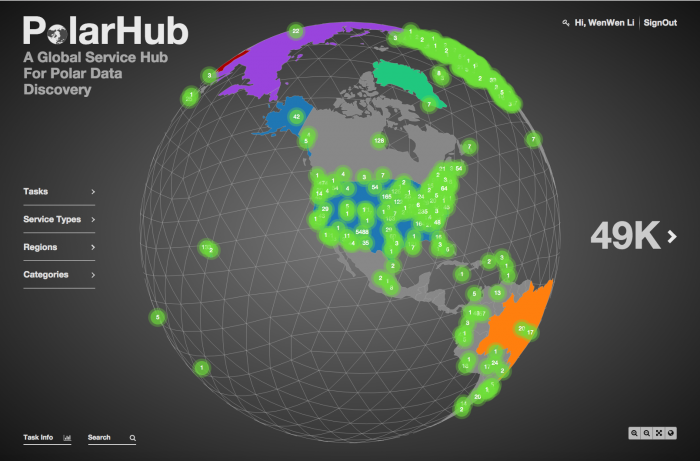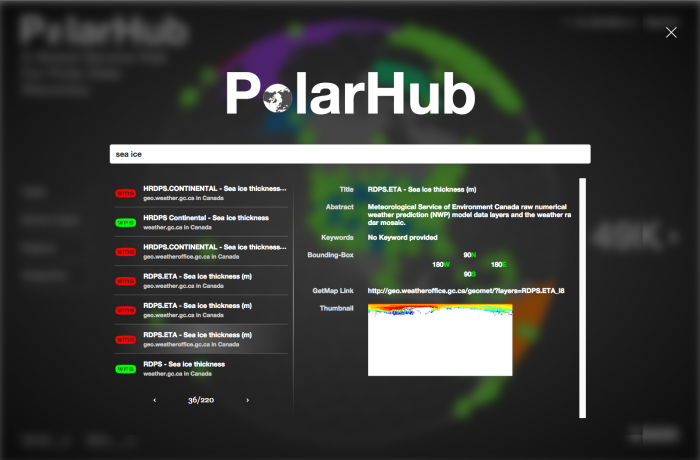By Wenwen Li, PhD, Assistant Professor, GeoDa Center for Geospatial Analysis and Computation, School of Geographical Sciences and Urban Planning, Arizona State University
Substantial research attention has been directed to the polar regions in recent years because they are key drivers of the Earth's climate, a source of rich mineral resources, and home to a variety of marine life. Due to climate change, the polar systems are being pushed towards a tipping point: the polar environment is at high-risk from melting snow and sea ice, permafrost thawing, and acidification of the Arctic oceans. To advance our understanding of the polar climate system and its impacts on the environment, economy, and people at local, regional, and global scales, there is a pressing need for a new cyberinfrastructure to improve the accessibility, usability, and visibility of polar scientific data.
A two-year research project funded by the National Science Foundation in 2014-2015 aims at developing a cutting-edge cyberinfrastructure portal to help polar scientists effectively and efficiently collect polar data, integrate knowledge, and analyze scientific phenomena to support effective decision making. This project is a collaborative effort between Principal Investigator (PI) Wenwen Li from Arizona State University, and Co-PI Chaowei Yang from George Mason University.
During the course of the project, Li is leading the effort to create building blocks of a polar cyberinfrastructure to support efficient data discovery and access. The main goal of this project is to transform the old science paradigm (80% of time searching for data and 20% time used for analysis) by providing tools that will enable better access to polar data and information. A cybersearch engine, the PolarHub, has been established to continuously mine the Internet to discover dispersed polar data resources to support various polar applications.
The PolarHub system introduces an innovative large-scale web mining technique to enable a scalable, sustainable, and interactive platform for polar data and service discovery. At present, PolarHub 2.0 has been launched at Arizona State University. A prominent feature of PolarHub 2.0 is the emphasis on collaborative data discovery and community involvement. Its graphic user interface allows end users to interact with the PolarHub service repository to search for PolarHub-discovered services, to create a new Web crawling task that searches for more service instances on the Internet, and to dynamically visualize the changing distribution pattern of identified services. So far, PolarHub has identified more than 49,000 geospatial data services that provide web map data, web coverage data, web feature data, and sensor observation data. These datasets contain almost 2 million unique data layers depicting the environmental, atmospheric, and social conditions of the poles and the rest of the world. This number continues to increase as PolarHub finds additional datasets. To interact with the system and find polar data, go here.


The long-term goal of Li's research is to establish a central data repository, or a global hub, for widely dispersed polar data to increase accessibility and re-usability; bridge the gap between polar data providers and consumers; and eventually provide timely support for spatial decision-making and discovery of new knowledge. As we enter the era of big (geo) data, PolarHub provides a new platform for users to "surf" the data deluge—supporting insightful polar data acquisition and analytics.
This project will contribute to the growth of a "cyberpolar" community through collaboration among Geographic Information System (GIS) scientists, polar scientists, and computer scientists focusing on specific polar issues. Results will be incorporated into lessons and hands-on experience for undergraduate and graduate students through classroom activities.
To interact with the PolarHub 2.0 and find polar data, go to the live system here. For more information about the project and its outcomes, please contact Wenwen Li (Wenwen [at] asu.edu).
